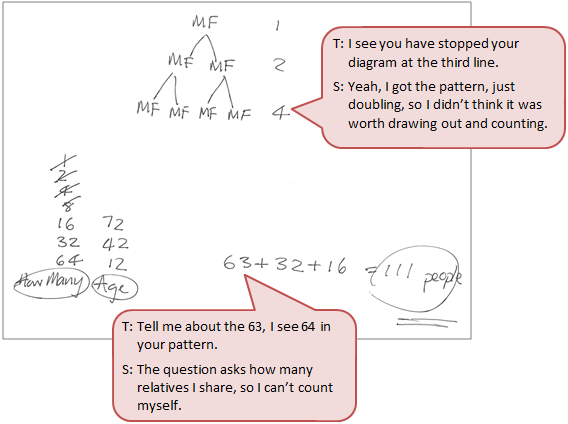So Many Relatives
The purpose of this activity is to engage students in solving a problem involving investigating with whole numbers using graphical means and/or generalising.
This activity assumes the students have experience in the following areas:
- Using diagrams to represent a growth pattern.
- Using diagram to represent and find specific unknown values.
- Writing rules that generalise how a pattern works.
The problem is sufficiently open ended to allow the students freedom of choice in their approach. It may be scaffolded with guidance that leads to a solution, and/or the students might be given the opportunity to solve the problem independently.
The example responses at the end of the resource give an indication of the kind of response to expect from students who approach the problem in particular ways.

The average person (with their partner) has two children before the age of 30 (that grow up to have their own….) and then lives to 75 years of age.
With approximately how many people living on the planet do you share each of your great great great great grandparents?
The following prompts illustrate how this activity can be structured around the phases of the Mathematics Investigation Cycle.
Make sense
Introduce the problem. Allow students time to read it and discuss in pairs or small groups.
- Do I understand the situation and the words? (Students may need support to understand the assumptions. The assumptions about birth rate and age may not be aligned with students’ personal experience. Students may need help with the terms average and biological.)
- What experiences can you draw on from real life/the world to help you?
- What will my solution look like? (The solution will be a decision on how many people share great-great-great-great grandparents with you and a justification for selecting that number.)
- How will the ages given of 30 and 75 affect the number of relatives you are likely to have on the planet?
- Do you have a sense of what the answer might be? How did you get that estimate?
Plan approach
Discuss ideas about how to solve the problem. Emphasise that, in the planning phase, you want students to say how they would solve the problem, not to actually solve it.
- What strategies will be helpful to solve this problem? (Students might choose diagrams, tables, or equations to model the situation.)
- What is a good way to start solving the problem? Could I make the numbers simpler?
- What are the maths skills I need to work this out?
- What tools (digital or physical) could help my investigation?
Take action
Allow students time to work through their strategy and find a solution to the problem.
- Am I recording my working in a systematic way so I do not miss anything important?
- Is my diagram or table showing a pattern?
- How might I describe the pattern?
- Does the pattern help me to answer the question?
- Have I thought about how the average ages for births and deaths affect my answer?
- How do my results look different to others? Why could this be?
- Does my solution make sense? Does it match my estimation?
- Is there another possible answer or way to solve it?
Convince yourself and others
Allow students time to check their answers and then either have them pair share with other groups or ask for volunteers to share their solution with the class.
- What is the solution?
- Is my working clear for someone else to follow?
- Have I considered all the conditions in the problem?
- How would I convince someone else I am correct?
- What connections can I see to other situations?
- Could my strategies be applied to other problems or to this problem if the conditions were changes? How?
- Which ideas or tools worked well in my investigation?
- What could I try differently next time?
- What could I find out next?
Examples of work
Work sample 1
The student makes assumptions about age and birth rate and represents the number of direct descendants with a diagram to represent the pattern. They use the diagram to solve the problem.
Click on the image to enlarge it. Click again to close.
Work sample 2
The student makes correct assumptions, models the generational pattern with diagrams and/or generalises the pattern to solve the problem.

